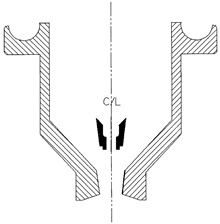Gardco / DIN 4mm Viscosity Cups
Article No. 13736
Gardco DIN Viscosity Cup 4mm
- The Gardco Standard DIN Viscosity Cup is 4mm
- In accordance with Deutsche Normen DIN 53211
Download Excel Viscosity Chart HERE
Certificate:
Features
- The Gardco/DIN 4mm viscosity cups conform to the flow characteristics specified by Deutsche Normen DIN 53211.
- Conversion formulas and tables relating efflux time in seconds, to the nearest tenth of a second, to viscosity in centistokes are furnished with each Gardco/DIN viscosity cup.
- Calibration of the Gardco/DIN cups are traceable to the National Institute of Stadards and Technology.
- The Gardco/DIN viscosity cup is machined from solid bar stock aluminum with removable stainless steel orifice.
The Gardco/DIN viscosity cups are in close agreement with the internal dimensions specified in DIN 53211 but with the following improvements: The mass of metal has been reduced to a minimum adjacent to the orifice for smallest possible temperature influence when cup and test material are not at the same temperature. The stainless steel orifice is of the readily removable type permitting replacement without significant loss of accuracy. The design of the cup and orifice eliminate hard to clean recesses. For greatest possible user convenience, the outside dimensions of the cup have been chosen for accommodations by support stands commonly in use with either the series of Gardco Standard Ford viscosity cups or the series of Gardco / ISO viscosity cups.
In addition to physical improvements, the Gardco/DIN cups are furnished with conversion formulas and a copyrighted table which relates the nearest tenth of a second of efflux time to viscosity in centistokes. The table is particularly useful in determining efflux time in seconds when viscosity in centistokes is known. As an additional service, the Gardco/DIN cups may be ordered with a Certificate of Calibration which contains calibration data with the use of oils traceable to the National Institute of Standards and Technology, and a calculated correction factor, if any, that may be used with the cup. Such viscosity cup certification procedures and conditions comply with the specifications of ANSI/NCSL Z540 or ISO/IEC 17025, ISO 9001 as applicable.
The Gardco/DIN viscosity cups are produced to very close mechanical tolerance in elaborate jigs and fixtures. Such production procedures and equipment not only insure that each cup is correctly produced but also that all cups are identical. The body of the cup is machined from solid bar stock aluminum and the orifice from stainless steel.
Certification - Any particular Gardco Standard DIN Cup or Gardco/Mini DIN Dip cup - orifice combination will be certified, as an extra cost service, to within 0.1 seconds and 0.1 degrees Centigrade on a standard oil selected for the combination midrange. Both the viscosity of the oil and the temperature measuring devices are traceable to National Institute of Standards and Technology. This certification complies to the requirements of ANSI/NCSL Z5401 or ISO/IEC 17025, ISO 9001 as applicable. Such certification is voided by the replacement of the cup orifice.
Orifices - Production tolerance on the Gardco Standard DIN cup and the Gardco/Mini DIN Dip cup and the orifice is sufficiently close to permit interchange of orifices between cups. For convenience and for best possible results, however, it is recommended that such interchanges be held to a minimum. The orifice for the cup is machined from stainless steel with the exact conical exterior to match the opening in the base of the cup.
DIN 4mm Standard Cup Only: Exterior cup dimensions are chosen to fit existing support stands for the Standard Ford and ISO viscosity cup series. Gardco/DIN cups are not matched by any other such cups with respect to the above advantages or in highest quality of workmanship or in continuing quality control procedures. The Gardco/DIN viscosity cup was designed by and is manufactured and calibrated by the Paul N. Gardner Company
Technical Attributes
-
- Data
-
Orifice Diameter (Nominal): 4mm Efflux Time Seconds Range: 15 to 20 Centistoke Range: 38 to 545 Midrange Sensitivity: (Centistokes per Second) 4.7 Standard Calibrating Oil: G100 Viscosity of Standard (Nominal Cs. - Use label value: 233
More Information
DIN Standard Cup
The body of the cup is machined from solid bar stock aluminum. Note from the cross section drawing of the cup the relatively deep well surrounding the top of the cup which serves to catch any overflow. Note also the conical opening for the orifice which permits gentle "tapping in" or "tapping out" of the orifice.
The stainless-steel orifice design provides for extension between the opening in the body and the lowermost extension of the cup. This design ensures protection for the orifice and prevents interference with the efflux stream by uneven or contaminated surfaces surrounding the orifice.

Click HERE for more information on Viscosity Cups.
Standards
DIN 53211
Procedure
- Insure that the cup is clean and that there is no residual dried material in or around the orifice.
- Insure that the test material is at specified measuring temperature.
- Place the cup in a suitable leveled holder and place a receiving container under the cup.
- Place a finger against the orifice and fill the cup with the test material until the meniscus, where it joins the sidewall of the cup, disappears. If there are bubbles in the sample, allow time for them to rise to the surface. If the cup is overfilled, remove the excess by sliding the cover plate across the top of the cup. With the plate in this position the finger may be removed. Remove the finger from the orifice or pull the scraper plate from the top of the cup and simultaneously start a timer.
- Hold a thermometer in the efflux stream in order to accurately determine the temperature of the test material.
- Stop the timer at the first observed break in the efflux stream between one and two inches below the orifice.
- Record the cup used, the designation and temperature of the test material and the number of seconds of efflux time. As an option to the preceding step, refer to the Viscosity Calculator App or conversion table for the cup to determine the centistoke viscosity for the measured efflux time in seconds and record this value and the measured temperature. (Example: Gardco/DIN 4mm, (test material), 25.1C, 41.2 Seconds.)
- Promptly clean the cup unless it will be used immediately for a rerun of the same material
Knowledge
Want to learn the perfect process for using a viscosity cup? The article link below provides information on how to choose the right viscosity cup, how to measure efflux time, how to remove calibration oils and much more. - The Proper Process for Measuring with a Viscosity Cup
Accessories
Other Variations

